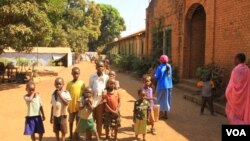It’s called the St. Mary Help of Christians Cathedral. And right now, the church is helping more than 8,500 South Sudanese who have fled fighting around the town of Wau, South Sudan, since violence erupted there in June.
“The church is like a faith-based organization that can also provide humanitarian assistance, and in times of trouble, you need to stand by your people,” said Francis Mogga, the camp officer.
But St. Mary’s, or the Cathedral IDP Center, as it’s now known, has become more than just a spiritual home for these internally displaced people, who have brought their families to live on the church grounds until they can return home.
Sitting behind a sewing machine inside a small shelter, with a tape measure around his neck, tailor Adam Edman Idriss said he moved to the cathedral in July, to flee violence.
“I think this is more safe than if I go back to my area, where I have to listen to the gunshots and the night robbery every time,” said Idriss.
Helping these newcomers is an undertaking of almost biblical proportions. While the church lends its space, Mogga explains that the World Food Program supplies food, Oxfam helps with water, the International Organization for Migration assists with healthcare and the U.N. Refugee Agency handles general protection.
Just across town is a U.N. protection of civilians, or PoC, site, which hosts another 29,000 IDPs. And although many of them are thankful for the assistance, they say they’d rather be home.
Sixty-six year-old Bernard Khabas has been living at this PoC site for six months. He says that he witnessed killing, raping and looting in June, which caused him to flee his home.
“Nobody wants to stay here, but because the life there is not safe, that’s why we are still here now,” said Khabas.
IDPs have described how uniformed men and young Dinka attacked areas primarily inhabited by ethnic Fertit in the June clashes. Prior to these attacks, Western Bahr el Ghazal had been spared much of the violence that had struck other parts of the country. The government has denied involvement by its soldiers, instead blaming the “rebels.”
Security is stricter at the U.N. site than the cathedral, but some church residents say they are getting help from a higher power.
“But the belief we have in faith, that we are Christian, we are praying every day, so this is how we are staying here without fearing anything bad may happen to us,” said Monica Ilario Kaima, a 40 year-old IDP who has been living at the church for five months.
Camp officials say they are hosting more than 3,600 IDPs at three other church locations around Wau. Despite the challenges, officials say they will continue doing so, until it’s safe for people to leave.











